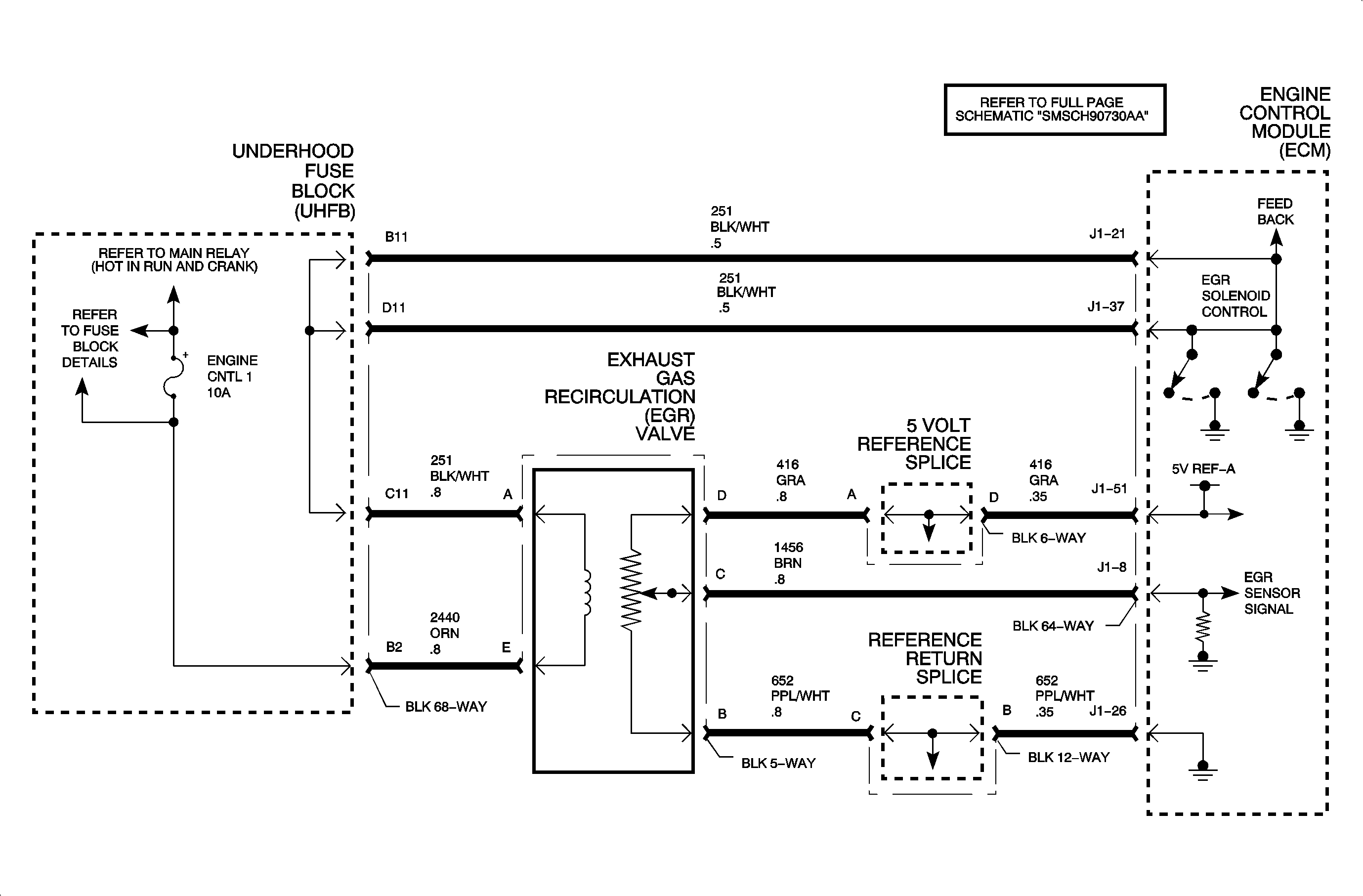
Circuit Description
The engine control module (ECM) controls the exhaust gas recirculation (EGR) valve with a solid state device called a driver. The driver supplies the EGR solenoid with a ground that is pulse width modulated (PWM) through the EGR solenoid control circuit. 12 volts is provided by the Engine CNTL 1 fuse through the ignition positive voltage circuit. The ECM uses a pull-up voltage of 2.6-4.6 volts to determine if a circuit is open, shorted to ground or shorted to voltage. If the ECM detects a pull-up voltage more than 4.6 volts with the EGR commanded, indicating a short to voltage, DTC P1405 sets.
Conditions for Running the DTC
| • | The engine speed is more than 40 RPM. |
| • | The ignition voltage is between 7.5-15 volts. |
| • | The EGR valve is commanded to open. |
Conditions for Setting the DTC
| • | The ECM detects a short to voltage in the control circuit of the EGR solenoid. |
| • | The above condition is met for more than 0.5 seconds. |
Action Taken When the DTC Sets
| • | The control module illuminates the malfunction indicator lamp (MIL) on the second consecutive ignition cycle that the diagnostic runs and fails. |
| • | The control module records the operating conditions at the time the diagnostic fails. The first time the diagnostic fails, the control module stores this information in the Failure Records. If the diagnostic reports a failure on the second consecutive ignition cycle, the control module records the operating conditions at the time of the failure. The control module writes the operating conditions to the Freeze Frame and updates the Failure Records. |
Conditions for Clearing the MIL/DTC
| • | The control module turns OFF the malfunction indicator lamp (MIL) after 3 consecutive ignition cycles that the diagnostic runs and does not fail. |
| • | A current DTC, Last Test Failed, clears when the diagnostic runs and passes. |
| • | A history DTC clears after 40 consecutive warm-up cycles, if no failures are reported by this or any other emission related diagnostic. |
| • | Clear the MIL and the DTC with a scan tool. |
Step | Action | Yes | No |
|---|---|---|---|
Schematic Reference: Engine Controls Schematics Connector End View Reference: Engine Controls Connector End Views or Engine Control Module Connector End Views | |||
1 | Did you perform the Diagnostic System Check-Engine Controls? | Go to Step 2 | |
2 |
Important: The exhaust gas recirculation (EGR) valve pintle may not move until more than 40 percent duty cycle is applied.
Does the EGR Sensor parameter read more than 4 volts when commanded with a scan tool? | Go to Step 3 | Go to Step 4 |
3 |
Did the DTC fail this ignition? | Go to Step 4 | |
4 |
Notice: Refer to Test Probe Notice in the Preface section.
Is the voltage more than 4.6 volts? | Go to Step 5 | Go to Step 6 |
5 | Test the control circuit of the EGR solenoid for a short to voltage. Refer to Circuit Testing and Wiring Repairs in Wiring Systems. Did you find and correct the condition? | Go to Step 10 | Go to Step 7 |
6 | Test for shorted wire terminals at the EGR valve. Refer to Testing for Intermittent Conditions and Poor Connections and Connector Repairs in Wiring Systems. Did you find and correct the condition? | Go to Step 10 | Go to Step 8 |
7 | Test for shorted wire terminals at the engine control module (ECM). Refer to Testing for Intermittent Conditions and Poor Connections and Connector Repairs in Wiring Systems. Did you find and correct the condition? | Go to Step 10 | Go to Step 9 |
8 | Replace the EGR valve. Refer to Exhaust Gas Recirculation Valve Replacement . Did you complete the replacement? | Go to Step 10 | -- |
9 | Replace the ECM. Refer to Engine Control Module Replacement . Did you complete the replacement? | Go to Step 10 | -- |
10 |
Did the DTC fail this ignition? | Go to Step 2 | Go to Step 11 |
11 | Observe the Capture Info with a scan tool. Are there any DTCs that have not been diagnosed? | System OK | |
